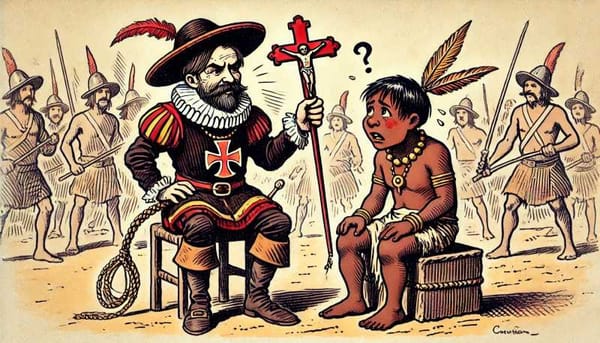The unknown history of Atotoztli, the first (and only) ruler of Mexico
Her role in the history of ancient Mexico has been told very limited, both in the pre-Hispanic chronicles themselves and in the narrations of the Spanish conquistadors.

In Mexico, there are cities, monuments, streets, and even metro stations with names like Moctezuma or Cuauhtémoc, a form of homage to those rulers of the Mexica empire (descendant of the Aztec). But from Atotoztli there is nothing like that. The name Atotoztli may not sound familiar to many.
Her role in the history of ancient Mexico has been told very limited, both in the pre-Hispanic chronicles themselves and in the narrations of the Spanish conquistadors. An illustration of the name of Atotoztli and her social position in the Mexica dynasty appears in a plate of the "Codex Azcatitlán" elaborated after the Spanish conquest, but there is not much more.
"She was a key figure in the continuity of the empire's dynasty," say historians Filiberto Romo and Enrique Aguilar is one of the few studies that exist on the subject. One fact presumably erased her from the account of who ruled one of the largest empires in pre-Hispanic America: Atotoztli was a woman.
"Possibly not only was she the carrier of the lineage, but, having the legitimate right to reign, she did it, she was queen and ruled".
But as in many cultures, even to the present, women's access to power was considered disrespectful.
"It was not in the custom to place a woman at the head of the government of a warlike nation, given that it would be improper and disrespectful to the warriors," say Romo and Aguilar.
Her title as the first Mexican ruler, whether pre-Hispanic, colonial, or modern, was not granted.
The princess Atotoztli
Approximately in 1325, the Aztecs established their empire in Mexico-Tenochtitlan, the current Mexico City. Its political organization developed as a monarchy with a dynastic family, whose transmission of power was given in a semi-hereditary way among males.
The fifth ruler, known by the Nahuatl tlatoani, of the dynasty, was Moctezuma Ilhuicamina, who fathered Atotoztli, as established in the historiographical documents "Genealogy of the Mexican princes" and the "Codex Mexicanus".
The Mexica kings had multiple children and Moctezuma Ilhuicamina was not the exception, he had other sons, among them one called Iquehuacatzin. The male occupied the high rank of tlacatéccatl, a position considered preparatory to occupy the position of tlatoani.
But for some reason, the sources of the time do not make it clear why at the death of Moctezuma I (1469) his son was omitted as a tlatoani. He died in a battle in 1472, according to the "Anales de Tlatelolco" codex. Atotoztli belonged to the caste of kings who dominated the Mexica empire from its foundation until its fall.
Atotoztli was the ruler's only daughter and as a woman, what anthropologist Rudolf van Zantwijk considers a "real Aztec drama" in succession occurred.
"There remains the mystery of why the Mexicans preferred Atotoztli over his brother Iquehuacatzin, but once that prince was eliminated, she appears as the most logical candidate," the researcher points out.
What records speak of Atotoztli
The succession system is a terrain not yet much explored by history, but anthropologist Van Zantwijk offers an interpretation.
"In the cases of succession by one or more of the brothers of an earlier tlatoani, after having governed the brothers, the function returned to a descendant of that one among them (the brothers) who occupies the position as immediate successor".
Moctezuma, I was tlatoani after the death of his brother Itzcóatl, but since his son Iquehuacatzin did not inherit the position, the interregnum conflict was generated, that is, an interruption in the succession.
Some documents establish that Atotoztli was the heir and held the position, according to recent historiographical investigations. In the "Ramírez Codex," it is established that Moctezuma I governed with his daughter from 1440 to 1469. "Relation of Genealogy," says that at the death of his father, Atotoztli ruled four years (1469-1473) and then was succeeded by one of her sons. And "Origin of the Mexicans" relates that the woman governed with her husband between 1470 and 1482, but does not offer more details.
In addition, Fray Toribio de Benavente, Motolinia, in History of the Indians of New Spain, says that the woman governed between 1469 and 1481, and Francisco López de Gómara wrote that "Axayaca was king after his mother".
The unnamed queen
The stories of Mexican history were written after the conquest of the Spanish, so both these documents and the chronicles of the conquerors are interpretations of the past. Atotoztli had married her cousin Tezozómoc, son of her uncle and tlatoaniItzcóatl, with whom she had three children: Axayácatl, Tizoc, and Ahuizotl.
Despite the other references, the story of the dominant story tells that the Mexica empire had as a successor to Moctezuma I, his grandson Axayácatl, and Tizoc and Ahuzitl followed him.
The role of Atotoztli is omitted in the sources of pre-Hispanic history most cited in the following centuries. The anthropologist Susan D. Gillespie tells BBC World that Atotoztli "stands out more than any other woman in the line of the royal family" Mexica. However, she believes that the lack of documents and sources of the Mexicas make it difficult to determine their place in history.
"Nobody can know if she governed or not, or even if she existed because there are no surviving indigenous historical documents from before the conquest of 1521. Everything we have was written afterward." But its existence for other experts sounds logical in light of how the role of women in Mexican society was considered, and mainly in the patriarchal system of government.
"It was considered as an anomaly the exercise of the external leadership of a political system by a woman. That is why most of the historical sources of Aztec origin do not mention the Atotoztli government period," says Van Zantwijk.
Source: BBC World




